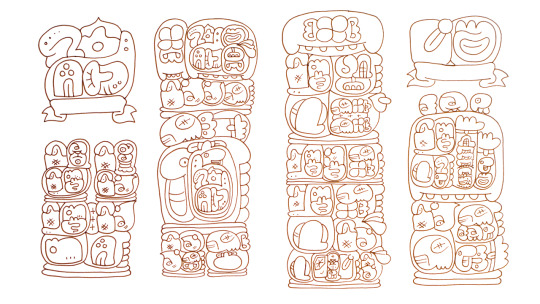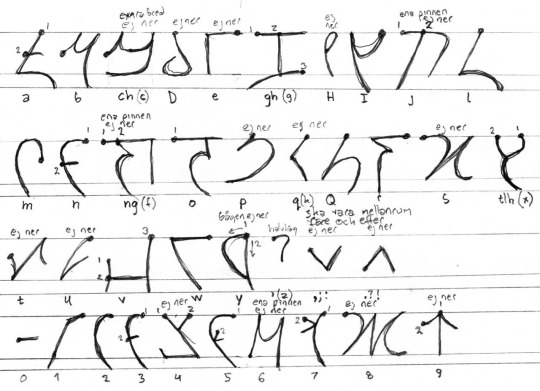#Sanskrit Scientific Consonants
Video
youtube
Sanskrit Grammar, has been created with a deep knowledge and understanding of the human anatomy!
But, you have heard such claims already!
Don't just believe them because someone says so.
Try this simple experiment, to find out how "Scientific" the Language is, for yourself.
1 note
·
View note
Photo

“what language should I learn?”
“is it better to learn [x] or [x]?”
“is it worth learning [x]?”
I get this type of question a lot and I see questions like these a lot on language learning forums, but it’s very difficult to answer because ultimately language learning is a highly personal decision. Passion is required to motivate your studies, and if you aren’t in love with your language it will be very hard to put in the time you need. Thus, no language is objectively better or worse, it all comes down to factors in your life. So, I’ve put together a guide to assist your with the kind of factors you can consider when choosing a language for study.
First, address you language-learning priorities.
Think of the reasons why are you interested in learning a new language. Try to really articulate what draws you to languages. Keeping these reasons in mind as you begin study will help keep you focused and motivated. Here are some suggestions to help you get started, complete with wikipedia links so you can learn more:
Linguistic curiosity?
For this, I recommend looking into dead, literary or constructed languages. There are lots of cool linguistic experiments and reconstructions going on and active communities that work on them! Here’s a brief list:
Dead languages:
Akkadian
Egyptian (Ancient Egyptian)
Gaulish
Gothic
Hittite
Old Prussian
Sumerian
Older iterations of modern day languages:
Classical Armenian
Classical Nahuatl (language of the Aztec Empire)
Early Modern English (Shakespearean English)
Galician-Portuguese
Middle English (Chaucer English)
Middle Persian/Pahlavi
Old English
Old French
Old Spanish
Old Tagalog (+ Baybayin)
Ottoman Turkish
Constructed:
Anglish (experiment to create a purely Anglo-Saxon English)
Esperanto
Interlingua
Láadan (a “feminist language”)
Lingua Franca Nova
Lingwa de Planeta
Lobjan
Toki Pona (a minimalist language)
Wenedyk (what if the Romans had occupied Poland?)
Cultural interests?
Maybe you just want to connect to another culture. A language is often the portal to a culture and are great for broadening your horizons! The world is full of rich cultures; learning the language helps you navigate a culture and appreciate it more fully.
Here are some popular languages and what they are “famous for”:
Cantonese: film
French: culinary arts, film, literature, music, philosophy, tv programs, a prestige language for a long time so lots of historical media, spoken in many countries (especially in Africa)
German: film, literature, philosophy, tv programs, spoken in several Central European countries
Italian: architecture, art history, catholicism (Vatican city!), culinary arts, design, fashion, film, music, opera
Mandarin: culinary arts, literature, music, poetry, tv programs
Japanese: anime, culinary arts, film, manga, music, video games, the longtime isolation of the country has developed a culture that many find interesting, a comparatively large internet presence
Korean: tv dramas, music, film
Portuguese: film, internet culture, music, poetry
Russian: literature, philosophy, spoken in the Eastern Bloc or former-Soviet countries, internet culture
Spanish: film, literature, music, spoken in many countries in the Americas
Swedish: music, tv, film, sometimes thought of as a “buy one, get two free” deal along with Norwegian & Danish
Religious & liturgical languages:
Avestan (Zoroastrianism)
Biblical Hebrew (language of the Tanakh, Old Testament)
Church Slavonic (Eastern Orthodox churches)
Classical Arabic (Islam)
Coptic (Coptic Orthodox Church)
Ecclesiastical Latin (Catholic Church)
Ge’ez (Ethiopian Orthodox Church)
Iyaric (Rastafari movement)
Koine Greek (language of the New Testament)
Mishnaic Hebrew (language of the Talmud)
Pali (language of some Hindu texts and Theravada Buddhism)
Sanskrit (Hinduism)
Syriac (Syriac Orthodox Church, Maronite Church, Church of the East)
Reconnecting with family?
If your immediate family speaks a language that you don’t or if you are a heritage speaker that has been disconnected, then the choice is obvious! If not, you might have to do some family tree digging, and maybe you might find something that makes you feel more connected to your family. Maybe you come from an immigrant community that has an associated immigration or contact language! Or maybe there is a branch of the family that speaks/spoke another language entirely.
Immigrant & Diaspora languages:
Arbëresh (Albanians in Italy)
Arvanitika (Albanians in Greece)
Brazilian German
Canadian Gaelic (Scottish Gaelic in Canada)
Canadian Ukrainian (Ukrainians in Canada)
Caribbean Hindustani (Indian communities in the Caribbean)
Chipilo Venetian (Venetians in Mexico)
Griko (Greeks in Italy)
Hutterite German (German spoken by Hutterite settlers of Canada/US)
Fiji Hindi (Indians in Fiji)
Louisiana French (Cajuns)
Patagonian Welsh (Welsh in Argentina)
Pennsylvania Dutch (High German spoken by early settlers of Canada/ the US)
Plaudietsch (German spoken by Mennonites)
Talian (Venetian in Brazilian)
Texas Silesian (Poles in the US)
Click here for a list of languages of the African diaspora (there are too many for this post!).
If you are Jewish, maybe look into the language of your particular diaspora community ( * indicates the language is extinct or moribund - no native speakers or only elderly speakers):
Bukhori (Bukharan Jews)
Hebrew
Italkian (Italian Jews) *
Judeo-Arabic (MENA Jews)
Judeo-Aramaic
Judeo-Malayalam *
Judeo-Marathi
Judeo-Persian
Juhuri (Jews of the Caucasus)
Karaim (Crimean Karaites) *
Kivruli (Georgian Jews)
Krymchak (Krymchaks) *
Ladino (Sephardi)
Lusitanic (Portuguese Jews) *
Shuadit (French Jewish Occitan) *
Yevanic (Romaniotes)*
Yiddish (Ashkenazi)
Finding a job?
Try looking around for what languages are in demand in your field. Most often, competency in a relevant makes you very competitive for positions. English is in demand pretty much anywhere. Here are some other suggestions based on industry (from what I know!):
Business (General): Arabic, French, German, Hindi, Korean, Mandarin, Russian, Spanish
Design: Italian (especially furniture)
Economics: Arabic, German
Education: French, Spanish
Energy: Arabic, French, German, Portuguese, Russian, Spanish
Engineering: German, Russian
Finance & Investment: French, Cantonese, German, Japanese, Mandarin, Russian, Spanish
International Orgs. & Diplomacy (NATO, UN, etc.): Arabic, French, Mandarin, Persian, Russian, Spanish
Medicine: German, Latin, Sign Languages, Spanish
Military: Arabic, Dari, French, Indonesian, Korean, Kurdish, Mandarin, Pashto, Persian, Russian, Spanish, Turkish, Urdu
Programming: German, Japanese
Sales & Marketing: French, German, Japanese, Portuguese
Service (General): French, Mandarin, Portuguese, Russian, Sign Languages, Spanish
Scientific Research (General): German, Japanese, Russian
Tourism: French, Japanese, Mandarin, Sign Languages, Spanish
Translation: Arabic, Russian, Sign Languages
Other special interests?
Learning a language just because is a perfectly valid reason as well! Maybe you are really into a piece of media that has it’s own conlang!
Fictional:
Atlantean (Atlantis: The Lost Empire)
Dothraki (Game of Thrones)
Elvish (Lord of the Rings)
Gallifreyan (Doctor Who)
High Valyrian (Game of Thrones)
Klingon (Star Trek)
Nadsat (A Clockwork Orange)
Na’vi (Avatar)
Newspeak (1984)
Trigedasleng (The 100)
Vulcan (Star Trek)
Or if you just like to learn languages, take a look maybe at languages that have lots of speakers but not usually popular among the language-learning community:
Arabic
Bengali
Cantonese
Hindi
Javanese
Hausa
Indonesian
Malay
Pashto
Persian
Polish
Punjabi
Swahili
Tamil
Telugu
Thai
Turkish
Urdu
Vietnamese
Yoruba
If you have still are having trouble, consider the following:
What languages do you already speak?
How many and which languages you already speak will have a huge impact on the ease of learning.
If you are shy about speaking with natives, you might want to look at languages with similar consonant/vowel sounds. Similarity between languages’ grammars and vocabularies can also help speed up the process. Several families are famous for this such as the Romance languages (Spanish, Portuguese, Italian, French, Romanian), North Germanic languages (Norwegian, Swedish, Danish) or East Slavic languages (Russian, Ukrainian, Belarusian). If you are a native English speaker, check out the FSI’s ranking of language difficulty for the approximate amount of hours you’ll need to put into different languages.
You could also take a look at languages’ writing systems to make things easier or for an added challenge.
Another thing to remember is that the languages you already speak will have a huge impact on what resources are available to you. This is especially true with minority languages, as resources are more frequently published in the dominant language of that area. For example, most Ainu resources are in Japanese, most Nheengatu resources are in Portuguese, and most Nahuatl resources are in Spanish.
What are your life circumstances?
Where you live with influence you language studies too! Local universities will often offer resources (or you could even enroll in classes) for specific languages, usually the “big” ones and a few region-specific languages.
Also consider if what communities area near you. Is there a vibrant Deaf community near you that offers classes? Is there a Vietnamese neighborhood you regularly interact with? Sometimes all it takes is someone to understand you in your own language to make your day! Consider what languages you could realistically use in your own day-to-day. If you don’t know where to start, try checking to see if there are any language/cultural meetups in your town!
How much time can you realistically put into your studies? Do you have a fluency goal you want to meet? If you are pressed for time, consider picking up a language similar to ones you already know or maintaining your other languages rather than taking on a new one.
Please remember when choosing a language for study to always respect the feelings and opinions of native speakers/communities, particularly with endangered or minoritized languages. Language is often closely tied to identity, and some communities are “closed” to outsiders. A notable examples are Hopi, several Romani languages, many Aboriginal Australian languages and some Jewish languages. If you are considering a minoritized language, please closely examine your motivations for doing so, as well as do a little research into what is the community consensus on outsiders learning the language.
#o#writing this post took a long time but it was really fun!!#langblr#language learning#choosing a language
2K notes
·
View notes
Text
Top Dead and Constructed Languages to Learn

Top Dead and Constructed Languages to Learn - Sciforce - Medium
As a rule, when we choose a language to learn, we have several reasons in mind: they might be useful for our professional growth or helpful in travels or in communication with certain communities. We might need a language because we move to another country or because we fall in love with a foreigner. However, a new language can be not only a means of communication: it is also a way to sharpen your mind, to find a deeper mental structure in what might first seem to be verbal chaos — and ultimately it can become a proxy to mastering computer logic and machine learning.
That is why it is a good idea to learn not a real live language — but a tongue that is dead and reconstructed or completely invented. Striped of numerous exceptions, variations and usage simplification that are inherent to natural languages we speak, they show only the ideal logical structure in the core of any language — be it human, computer, or mathematical.
In this blog post, we’ll present a list of our top of dead and artificial languages that might be useful to learn.
Dead Languages

Latin
Much more than a dead language of a dead ancient Empire, Latin is the language that had an enormous impact on the development of other European languages, as well as on the European culture and science.
Why to learn?
Latin is the parent of the modern Romance languages, which include Spanish, French, Italian, Portuguese and others. Therefore, the knowledge of Latin can facilitate learning these languages — and train you to see and to use the connections and similarities between them. These connections are so huge that learning Latin will virtually open up access to the whole Romance language family — and boost your analytical skills.
Latin is a highly-inflected language, which means that you can alter the meanings of words by merely changing the ending suffice. On the one hand, it makes Latin difficult to learn; on the other hand, it gives you an idea of the power of minute changes and a good eye for detail. And you’ll see that Latin IS well-structured!
Latin is not so dead as we might think. It is used, of course, in Catholic Church, but, more importantly, it is the basis of medical and biological classifications and to a certain extent of the academic slang.
Where to learn?
Latin might be offered to you at your university (it might be also a compulsory course), so grab the chance!
There are of course numerous courses and learning resources for any level:
Getting started on classical Latin is a free course that is aimed not at mastering the language itself but rather at discovering Latin grammar structures and its impact on English.
Learn Latin is a free app that provides users with vocabulary (verbs, nouns, adjectives, adverbs) that they can easily use to learn a word a day. Example sentences will also be provided to help learn the new word.
New Latin Grammar — a textbook for those who like explicit explanations.

unsplash.com
Sanskrit
Similar to Latin in Europe, Sanskrit was the lingua franca of the Indian subcontinent for three millennia and it provided the foundational texts for Hinduism, Buddhism, Sikhism and Jainism.
Why to learn?
Sanskrit has a huge impact on modern Indo-Aryan languages, such as Hindi that directly borrows Sanskrit grammar and vocabulary. Its influence reaches other languages, including Austronesian, Sino-Tibetan, and the languages of Southeast Asia.
The 49-character alphabet arranges characters in a rational and systematic manner: both the vowels and consonants are arranged according to the shape of the mouth when these sounds are emitted.
The morphology of word formation is unique and of its own kind where a word is formed from a tiny seed root in a precise grammatical order which has been the same since the very beginning. Any number of new words could be created from the root with the help of an extremely detailed prefix and suffix system.
The current global interest in Sanskrit is connected with the spread of yoga practices and Indian way of life around the world, so it has become a trendy language among people who declare to live “clean”.
Where to learn?
Learn Sanskrit online — an online course for beginners that features a rather informal approach to learning a new language.
Sanskrit grammar — in case you don’t want to actually speak Sanskrit but would prefer to use it as a tool to train your mind.
Ancient Greek

Classical, or Ancient, Greek is often considered the most important language in the intellectual life of Western civilization. While it does use an older and more foreign alphabet, learning Ancient Greek can allow you to read many ancient intellectual texts.
Why to learn?
Though not as evident as Latin, Greek has traces in modern academic languages: for instance, many of the modern English names of scientific disciplines come from Ancient Greek, including psychology, philology, theology, philosophy, etc.
The Greek alphabet was taken over from the Semitic as used in the Phoenician area, which in turn was based on an Egyptian alphabet. That makes the Greek alphabet a link between Western alphabets and the morphology of alphabets across Asia. Being familiar with the Greek alphabet is a definite advantage: even now, many technical studies borrow from the Greek alphabet and use it to a considerable degree.
Learning Ancient Greek can improve your understanding of grammar, since the sentence structure and the number of forms require a great deal of attention. The words of sentences are placed for their emphasis, rather than in accordance with a specific pattern, making the knowledge of the inflections highly important. Besides, inflections are attributes not only of nouns, but also of adjectives, pronouns, verbs and articles, so you need to keep an eye on all parts of speech simultaneously.
Where to learn?
Learn Ancient Greek is a free online course to learn the fundamentals of Classical Greek.
Introduction to Ancient Greek — is a traditional textbook that provides a thorough explanation of Ancient Greek grammar and morphology.
Hebrew

unitedwithisrael.org
Biblical Hebrew is the archaic form of modern Hebrew used to write the Old Testament of the Bible. Developed into a literary and liturgical language around 200 CE, it is currently taught in public schools in Israel, as an important way to understand modern Hebrew and the Jewish faith.
Why to learn?
It’s a very popular language for Jewish and Christian followers to study because it opens up the possibility for reading the Old Testament in its original language.
While it is similar to Modern Hebrew, the style, grammar, and vocabulary of Biblical Hebrew makes it much more difficult to learn. Having to establish the precise use of a case or mood or voice makes the interpreter consider all the various possibilities of meaning inherent in the language of the text. It sounds overcomplicated, but it is a perfect workout for your brains and the ability to consider all possibilities is a definite advantage.
Hebrew alphabet is also notoriously difficult to learn: in its traditional form, it consists only of consonants, written from right to left. It has 22 letters, five of which use different forms at the end of a word. Vowels are indicated by the weak consonants serving as vowel letters, or the letter can be combined with a previous vowel and becomes silent, or by imitation of such cases in the spelling of other forms. Bottom line, Biblical Hebrew is for those who like puzzles and mysteries hidden from the plain view.
Where to learn?
Biblical Hebrew Grammar — a course of 50 lessons covering the fundamentals of Ancient Hebrew
Biblical Hebrew — a set of online courses for different levels from absolute beginners to expert learners.
Old English

thoughtco.com
Old English, sometimes referred to as Anglo-Saxon, is the earliest historical form and the forefather of the contemporary English language. It was brought to Great Britain by Anglo-Saxon settlers probably in the mid-5th century and was spoken in England and Southern and Eastern Scotland in the early Middle Ages.
Why to learn?
Spoken in England before the Norman Conquest, Old English remains a truly Germanic language and shows the modern English connections to the Germanic family.
By learning Old English you can trace the evolution of a language over centuries on all levels from phonetic shifts to simplification of grammar and changes in vocabulary. This makes evident how a language responds to the changes in the society and how complicated grammar used to be.
Besides, it is written in the Anglo-Saxon variant of runes, so you can pretend to be a Viking.
Where to learn?
Old English Online is a course offered by the University of Texas where you will read through ancient texts building up your knowledge of Old English gradually.
Leornende Eald Englisc is a YouTube channel for those who likes less traditional and relaxed learning process.
Constructed Languages
Esperanto
Esperanto is the most successful international auxiliary language, with up to two million speakers. It was invented in the late 19th century by a Polish doctor, Ludwik Zamenhof, who wanted to end interethnic conflicts by providing everyone with a common and politically neutral tongue.

www.078.com.ua
Why to learn?
Contrary to old and dead languages, invented languages tend to simplify grammar and morphology. In Esperanto, word roots are mostly based on Latin and can be combined with affixes to form new words. The affixes can also stand alone: ejo = place, estro = leader/head, etc. The grammar has many traces of Slavic languages, although it is greatly simplified in comparison to them.
Spelling conventions are somewhat similar to Polish, though Zamenhof came up with some new letters for Esperanto (Ĉĉ, Ĝĝ, Ĥĥ, Ĵĵ, Ŝŝ, Ŭŭ). These letters are often replaced with ch, gh, jh or cx, gx, jx, or c’, g’, j’, etc.
Esperanto is an easy language to master with its small set of grammar rules and a transparent system of word endings: -o for nouns, -a for adjectives, -e for adverbs, -as for verbs in present tense. This makes grammar much clearer to a novice in language learning.
Where to learn?
Esperanto course– an app to learn basic Esperanto
Free Esperanto Course — a somewhat more traditional course explaining grammar rules and vocabulary.

https://en.wikipedia.org/wiki/Toki_Pona#/media/File:Sitelen_sitelen_contract.jpg
Toki Pona
Toki Pona is a language created by the Canadian linguist and translator Sonja Lang as a philosophical language for the purpose of simplifying thoughts and communication.
Why to learn?
Lang designed Toki Pona to express maximal meaning with minimal complexity and to promote positive thinking. One of Toki Pona’s main goals is a focus on minimalism, as it focuses on simple concepts and universal elements. The language has 120–125 root words and 14 phonemes designed to be easy to pronounce for speakers of various language backgrounds. Therefore, learning this language can help switch the focus from complexity to the minimum repertoire.
Inspired by Taoist philosophy, the language is designed to help users remove complexity from the thought process. Even with the small vocabulary, speakers are able to communicate, mainly relying on context, which highlights the importance of non-linguistic means of communication.
Where to learn?
o kama sona e toki pona! — a Toki Pona course introducing grammar rules and vocabulary
speak toki pona — an introductory audio course
Klingon

https://daily-klingon.tumblr.com/post/179493082615/this-is-the-piqad-script-as-developed-by-michael
Klingon, the language of a fictional warrior alien race in the Star Trek created by Marc Okrand and it is maybe the most famous constructed language.
Why to learn?
Perhaps the most fully realized science fiction language, Klingon has a complete grammar and vocabulary of 3000 words, so fans can actually learn it. There are even translations of Shakespeare, Sun Tzu and the Bible into the language.
Klingon was mostly created by a linguist who deliberately added complex rules and sounds that are rare in human languages. Therefore, this language, though not fully natural, can serve us as a proxy to understanding an alien — or at least a foreign — way of thinking and conceptualizing the world.
Another possible difficulty for anyone wanting to communicate in Klingon is that, as a space-based language, it’s lacking a lot of normal Earth words.

https://www.youtube.com/watch?v=K0cFLb-JmaQ
Star Trek: Into Darkness
Where to learn?
There’s a Klingon Language Institute, the purpose of which is to promote the language and culture of this nonexistent people.
Learn Klingon the Easy(ish) Way — an online course of Klingon on You Tube
Learn Klingon Online — a complete course of Klingon
Quenya

https://en.wikipedia.org/wiki/Fictional_language
Quenya is one of the languages invented by JRR Tolkien in his Middle-earth world. A ceremonial Elvish tongue, it’s the most elaborate of all of Tolkien’s languages.
Why to learn?
First of all, Middle Earth was invented for Quenya and not vice versa: Tolkien began to write his stories in order to provide his language with a historical background. Tolkien tried to create the most beautiful language imaginable, and the sounds and grammar were taken mostly from the real Earth languages that he thought were the most beautiful: Finnish, Latin and Greek.
The most striking feature of Quenya is that it is a highly agglutinating language, meaning that multiple affixes are often added to words to express grammatical function. It is possible for one Quenya word to have the same meaning as an entire English sentence. Therefore, Quenya helps master a completely different way of building sentences and shows the possibilities of language economy.
It uses a special set of Elfish runes featuring, among others, representation of vowels with diacritics and the correspondence between shape features and sound features, and of the actual letter shapes.

https://www.looper.com/34326/things-you-didnt-know-about-the-ring-in-lord-of-the-rings/
Lord of the Rings (yes, we know that it’s the Black speech written in Tengwar)
Where to learn?
Quenya course — a textbook explaining Elfish grammar and introducing vocabulary.
Quenya — the Ancient Tongue — a brief survey providing the basics of Quenya grammar
High Valyrian

https://gameofthrones.fandom.com/wiki/High_Valyrian
High Valyrian is a ceremonial language from A Song of Ice and Fire series of fantasy novels by George R. R. Martin. While High Valyrian is not developed beyond a few words in the novels, for the TV series, linguist David J. Peterson created both the High Valyrian language, and its derivative languages Astapori and Meereenese Valyrian.
Why to learn?
This is the most recently developed language for the most popular TV series, so learning it at present is timely and trendy.
A dead language in the world of Westeros, High Valyrian occupies a cultural niche similar to that of Latin being the language of learning and education among the nobility, so learning it can make you feel double sophisticated (or nerd).
Despite its complicated inflectional grammar, High Valyrian does not have a special alphabet, so it is easier to master reading from the very beginning without additional obstacles.

https://gameofthrones.fandom.com/ru/wiki/%D0%9A%D1%80%D0%B0%D1%81%D0%BD%D1%8B%D0%B5_%D0%B6%D1%80%D0%B5%D1%86%D1%8B?file=%D0%9C%D0%B5%D0%BB%D0%B8%D1%81%D0%B0%D0%BD%D0%B4%D1%80%D0%B0_5x01.jpg
Where to learn?
High Valyrian Course — an app teaching the basic vocabulary and phrases
Learning High Valyrian — resources on grammar, phonology and vocabulary developed by fans
It might be that constructed languages lack the depth as they do not have actual system of idioms and metaphors behind them, or that dead languages are overcomplicated and outdated and no one would be able to communicate in them at present. However, learning such languages is an excellent exercise for our mind that help us develop more focus and attention and understand more about the logic of a language, the way we shape it and the way we want artificial languages — including machine ones — to work.
1 note
·
View note
Video
youtube
Tips for proper sanskrit mantras chant Part - 3 Know how to pronounce mantra chanting correctly. In my first video on proper sanskrit mantra pronunciation and chanting. I had given an instruction to brought attention in syllables of vowel sounds and consonant sounds. Additionally, some brief description about the mantra. In the second video, I had included my personal pronunciation guidance, like mantra pronunciation audio sounds, on how to spell or pronounce correctly a vowel sounds that within each words of mantra. Each of the video, my focus is on pronounce mantras correctly to develop effectiveness in mantra chanting. Finally, at the end of the topic “Tips for proper sanskrit mantras chant on how to pronounce mantra chanting correctly” it specializes for english pronunciation of ancient mantra and also a guide for each seekers having willingness on mantra chanting. This final part of proper chanting of mantras is specially released for beginners needing fulfillment on their specific desires and also for the practitioner seeking a correct method and information to achieve success from the result of spending daily time on chanting of any mantras but as an outcome they do achieve exactly not as expected. Why we need japa mala for mantra chanting? Does 108 mantra beads really necessary in mantra meditation? Can’t we chant mantras without beads and yentras? Normally people use 108 beads of bodhi seeds, rudraksha mala, sandalwood, tulasi mala, bamboo beads, coconut beads, gemstones, crystal malal and plactic malas for mantra chanting. As mantra has no any age of discovery because mantras are being using from the ancient time that has no any history revealed. So in that age, people were using sun and moon to identify the period of the day and night. In order to measure the frequency of energy generated by pronunciation of sounds from mantra, ancient people were discovered a japa mala and chanting beads. In our modern days we have clock and watches as an alternative of japa mala and meditation beads. how mantra works scientifically? Do mantras have proven power? Proof that mantras worked instantly? How long do mantras take to work? Does listening to mantras works? Actually, mantra is not a magic. Mantra is a system of calling specific soul. Each mantra contained with ancient name of god. Therefore, chanting mantra means we are trying to communicate with powerful spirit that supposes to be a divine deity. When one gets into the biggest obstacle, in that time their mind not able to work, mind becomes zero states of thoughts. Constantly he or she consciously generates vibrations asking for overcome. It’s a type of feelings that comes from one’s personal heart. Such types of feelings is a desire in nature. Show now, here is the key to figure out, our needs are our desires and all desires starts from our heart not the mind. While chanting mantra, we have to focus on our specific desire that needed to be fulfilled. At first, Focus on your desire and it is your own heart. And second, feel brighten light within your heart, then the third, feel there is the essence of god who will help you to overcome from your blockage. Feel you love that soul and you pray for your progress. At the final, do not fully concentrate with the internal sound that comes in your chanting. But focus on the sounds of mantra chanting and feel that the sound is starting from your own heart. After you make a clean, pure and real purpose of your fulfillment, divine spirit will be delighted with your devotion. You do not hold any cosmic power. But, you will be blessed by the heavenly source with the cosmic divine powers for lifting up your real and needy desire. At the end, mantra is a way of communication between two different spirits. First is human soul and the second is divine soul. Source and the destination of communication is the heart, so meditate on your heart. When thoughts are minimized cosmic contact is formed starting from the heart to the crown. Crown to the divine source and from divine source, back to your heart. This is the hidden secret of the heart energy.
0 notes
Photo

Kuch Rishton ka Namak Duri hota hai Om Pitra Devaya Namaha - The Science & Importance of Pitru Shradh paksha Shradh rituals during Pitra paksha involves oblations to three preceding generations & to those in the linear family tree Gotra. The universe operates in a cyclical manner.. the spiritual dimension also has cyclical events.. the period during the 2nd paksha forthnight of Bhadrapada in September (beginning on Padyami & ending on new moon day Sarvapitri amavasya/Pitru Amavasya/Mahalaya amavasya) is when the astral plane of Pitrlok of our ancestors is closest to our Bhulok Earth.. on these days the constellations are such that the gateways to other dimensions open & energies of Pitrlok ancestors are allowed to reach out to us near ones on Earth. Spiritual Science: Our Atma soul incarnates into a physical body made up of the five elements in various permutations & combinations.. reincarnating birth after birth depending on the kind of karma's attained in our lifetimes.. some souls don’t reincarnate.. coz.. either they are finished with their karmic cycle of Bhulok Prithvilok.. or are stuck in different dimensions of existence & are unable to manifest in human body.. as their karmic balance is insufficient entitling them a human birth.. these souls remain suspended as energies in Pitrlok.. in bondages of undesired yonis or levels of existence.. they need energy from their respective Gotra DNA linear lineage to offset their karmic balance & move to higher astral Lok's or reincarnate again on Bhulok. Only when we are in a human body can we chant specific mantras & do physical rituals.. once out.. we are dependent on others for our salvation or rebirth. It is therefore our basic duty as family to perform certain rites & charity in the name of our ancestors.. it is for our ancestors that we are what we are today. Why Shradh done only for family? Genetics has proved that our DNA is relatively stable over 7 generations (3 above, us, 3 generations below us).. similarly our subtle astral energy DNA is connected to the DNA of 3 generations above.. this makes energy channeling & transfer possible from us to them.. this DNA connection alters a little after the great grandson.. connections get little weaker.. but are still similar for our entire Gotra linear family free. Someone without relatives or of unknown family.. then the king ruler prime minister of the land does Shradh for them. Mythology we know: Karna remembered for his charity Dan.. Mahabharata.. when he died and went to heaven.. was served food made of gold.. Karna surprised.. Indra told him he was only donating gold and gems his entire life.. he never offered food water to his ancestors or the poor.. Karna realized his mistake.. wanted to correct the same.. he was allowed to get back to earth for sixteen days and feed the needy.. ridding him of the problem. These sixteen days when Karna was on Earth were of the pitru paksha. Crows.. Kha Kha.. connection with Pitrudevtas? Sound of a crow 'Kha Kha' is the first consonant of Sanskrit. It has different meanings.. 'Kha' also means 'why'. It is said.. our intention as human birth is to seek & find.. this journey starts with finding answers to.. Who am I? Where did I come from? Where am I going to go after death?.. which we forget in daily life.. our departed ancestors who realize this.. remind us to constantly stick to our path of self enquiry. Science of Shradh rituals: Only 'shraddha' done with bhav faith is called ‘Shradh'.. for a thinking mind, faith gets stronger with logic science & reasoning.. which is why this blog.. complete benefits of Shradh are received by our Pitru dev ancestors when Shradh vidhi rituals are done with complete bhav by us.. our ritualistic actions which creates astral energy get transferred to our Pitru's via energy exchange which happens only in our state of Bhav gratitude. The Shradh vidhi procedure involves.. inviting our Pitru Dev's in their energy form manifestations to our location (mantras & movements).. creating a conducive environment for energy exchange.. through the rituals creating subtle energy for their utilization.. transferring the energy to them.. taking their blessings & wishing them best for their onward astral journeys. Their is scientific reasoning to all this.. position & right left shoulder shift of Janeu sacread thread (energy channeling).. mantra recitations (purifying & energizing atmosphere).. wearing a ring of Darbha grass on ring finger (Tej radiance generated by Darbha grass lifts energy generated through Mantras in upward direction & reduces interference from Raja-Tama energy).. reciting mantras with hand movement & postures (whirl-pooling & concentration of energy).. black sesame seeds (store houses of Raja-Tama energy frequencies similar to Pitru energy frequencies.. principle of like attract like).. copper plate (transmitter conductor of energy).. use of Bhrungaraj leaf (Tej frequencies emitted from it restrain & disintegrate momentum of Raja-Tampa particles generated from the unsatisfied desires of the Pitrus).. offering of water through fingers palm direction (energy transfer).. so on.. our Panditji Brahmins will answer if you desire to know every detail. Importantly, these regimented non-substitutable actions, ritual procedures have a strong scientific reasoning.. they cannot be skipped or changed as per our fancy.. that breaks the scientific formula & the achieved results are not what we desired for our beloved Pitru's. Our ancestors had perfected this formula over centuries.. let us do it correctly & teach our future generations so this formula of energy exchange will come useful to us during our astral energy states. #ManishBhutada It is said that Shradh Pitru paksha is an inauspicious evil period.. while there is a logical reason why new projects are not commenced during this period, how can a period where we are closer to our ancestors ever be evil.. just coz we can't celebrate something new.. inauspicious or evil? This period for me is a time to rejoice the splendour of my forefathers, I'm but just a shadow of there grandeur. Sonch badlo, ModiJi kya kya badlenge.
1 note
·
View note